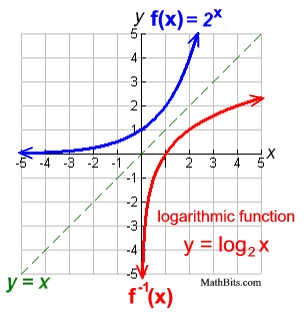Logarithms and Exponentials
Table of Contents
What is the relationship and differences between logarithms and exponentials?
They are fundamentally linked. Logarithms are the inverse operation of exponentiation.
They are two sides of the same coin, describing the same relationship between a base, an exponent, and a result, just from different perspectives.
Think of it like addition and subtraction, or multiplication and division. One undoes the other.

Exponential Functions
- They are functions where a constant base is raised to a variable exponent.
- Form:
y = b^x- e.g. 8 = 2^3
bis the constant base (b > 0,b ≠ 1)xis the variable exponentyis the result
- Purpose:
- Describes rapid growth (if
b > 1) or decay (if0 < b < 1). - Answers the question: “If I start with a base
band multiply it by itselfxtimes, what resultydo I get?”
- Describes rapid growth (if
- Example:
y = 2^3- Base
b = 2 - Exponent
x = 3 - Result
y = 2 * 2 * 2 = 8
- Base
- Key Characteristics:
- Domain: All real numbers (
xcan be anything) - Range:
y > 0(The result is always positive) - Graph: Passes through the point (0, 1) because
b^0 = 1. Has a horizontal asymptote aty = 0(the x-axis). Grows very quickly (forb > 1).
- Domain: All real numbers (
Logarithmic Functions
- They are the inverse of exponential functions. They find the exponent.
- Form:
x = log_b(y)(read as “log of y with base b equals x”)- e.g. log 8(2) = 3
bis the base (b > 0,b ≠ 1) - same base as the corresponding exponentialyis the argument (the number you’re taking the log of, which corresponds to the result of the exponential function) (y > 0)xis the result (which corresponds to the exponent in the exponential function)
- Purpose:
- Answers the question: “To what exponent
xmust I raise the basebto get the numbery?” - In other words, how many times do I have to cut down y (by base b) to reach x?
- “8” has to be cut down “3” times by base “2”.
- Answers the question: “To what exponent
- Relationship to Exponential: The statement
y = b^xis exactly equivalent tox = log_b(y). - Example:
log_2(8) = x- This asks: “To what power (
x) must I raise the base2to get8?” - Since
2^3 = 8, the answer isx = 3. - So,
log_2(8) = 3.
- This asks: “To what power (
- Key Characteristics (often written as
y = log_b(x)for function analysis):- Domain:
x > 0(You can only take the logarithm of a positive number) - Range: All real numbers (
ycan be anything) - Graph: Passes through the point (1, 0) because
log_b(1) = 0(sinceb^0 = 1). Has a vertical asymptote atx = 0(the y-axis). Grows very slowly.
- Domain:
Comparison Summary
| Feature | Exponential Function (y = b^x) |
Logarithmic Function (y = log_b(x)) |
|---|---|---|
| Relationship | Finds the result given a base and exponent | Finds the exponent given a base and result |
| Inverse Of | Logarithmic Function | Exponential Function |
| Standard Form | y = b^x |
y = log_b(x) |
| Variable is | Exponent (x) |
Argument (x) |
| Output is | Result of exponentiation (y) |
The required exponent (y) |
| Domain | All real numbers ((-∞, ∞)) |
Positive real numbers ((0, ∞)) |
| Range | Positive real numbers ((0, ∞)) |
All real numbers ((-∞, ∞)) |
| Key Point | Passes through (0, 1) |
Passes through (1, 0) |
| Asymptote | Horizontal (y = 0) |
Vertical (x = 0) |
| Growth Rate | Very fast (accelerating for b > 1) |
Very slow (decelerating) |
| Example | 8 = 2^3 |
3 = log_2(8) |
In Essence
- Exponentials scale things up (or down) very quickly based on the exponent.
- Logarithms scale things down, allowing us to deal with numbers that grow extremely large by focusing on their exponents. They are useful for measuring things that vary over huge ranges (like earthquake intensity - Richter scale, sound intensity - decibels, acidity - pH scale).
Reading material
https://mathbitsnotebook.com/Algebra2/Exponential/EXLogFunctions.html